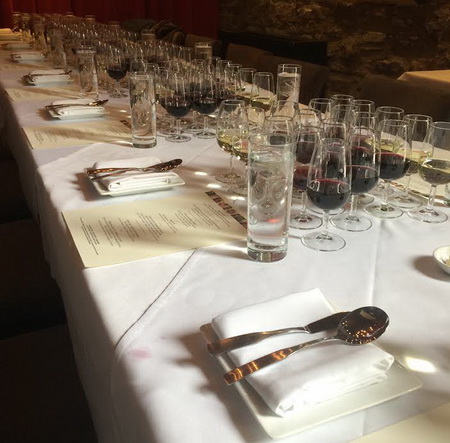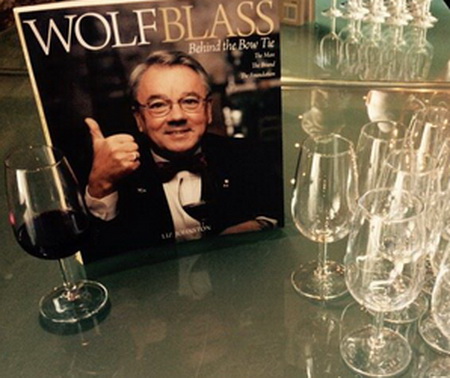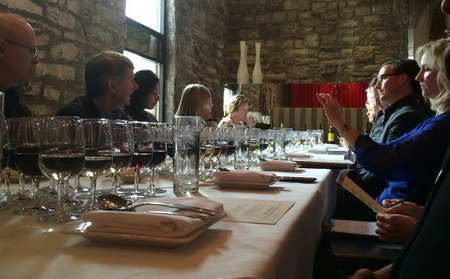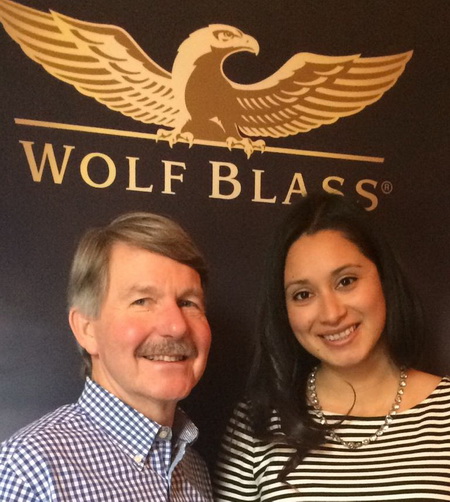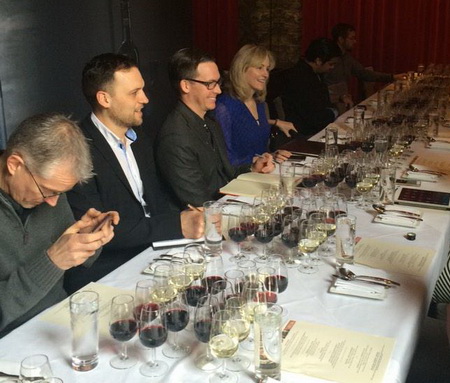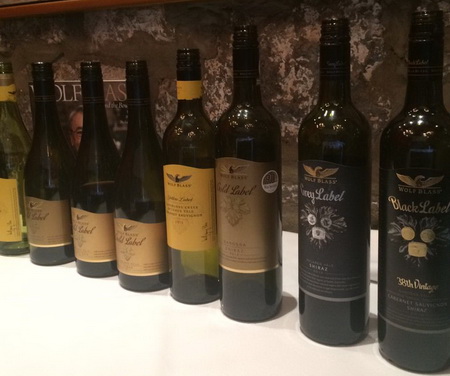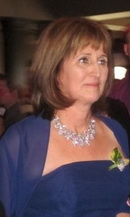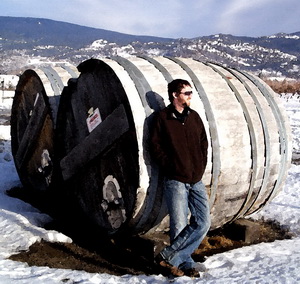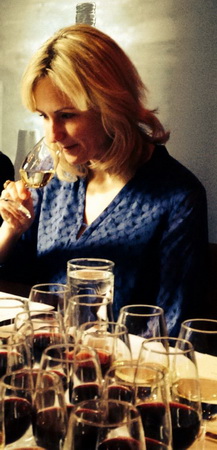Wolf Blass Winemaker Chris Hatcher shares some colourful history about Wolf Blass – the man, his history and work ethic – including an amusing story about a receptionist at the winery who didn’t believe that he was Wolf Blass ;)
“Despite being a multi-millionaire,” Chris added, “Wolf still maintains his driving work ethic and frugal mentality. Just before he checks out of a hotel, he still cleans out all the shampoo and soap.”
Christ Hatcher talking about the effect of fermentation by ‘committing a barrel’ to get that soft barrel character.
Some insights that surprised me:
– Wolf Blass first made 250 cases of the Grey Label Shiraz, but realized he could not earn a living based on such a small production of a premium-priced wine. Thus was born Yellow Label in 1966. It was created to be a crowd-pleaser with the goal of quality, character and consistency, according to current winemaker Chris Hatcher.
– Consistency is key as Yellow Label is designed to give consumers confidence that they are getting the same signature taste each time. That was the challenge to maintain when Yellow Label moved to regional selection of grapes for this vintage rather than widespread blending. Chris says that they achieve it through careful vineyard management and barrel selection.
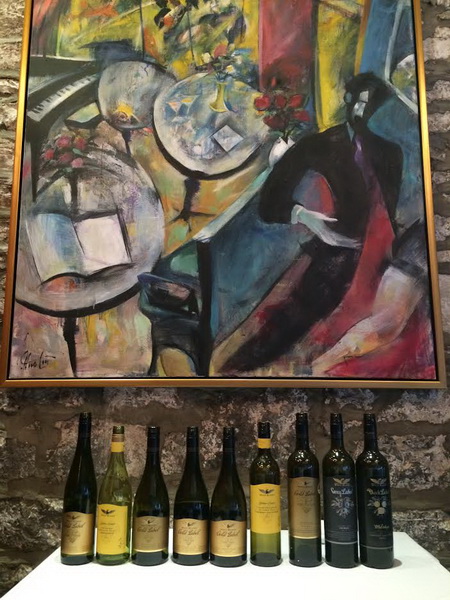 The diverse range of wines we tasted … see tasting notes below.
The diverse range of wines we tasted … see tasting notes below.
In this video Chris Hatcher talks about getting the complexity and balance correct.
The importance of on-site presence in the vineyard, resulting in a much better quality of wine, according to Chris Hatcher. The thumbs up is a universal sign apparently ;)
 Our tasting team deep in discussion (and wine).
Our tasting team deep in discussion (and wine).
 I was able to get their attention momentarily when I asked if anyone needed a top-up ;)
I was able to get their attention momentarily when I asked if anyone needed a top-up ;)
Chris Hatcher explaining how the terroir affects the taste of the wine.
More insights:
– Did you know that 99% of Australian rieslings are dry? While winemakers tried to make off-dry, and even sweet versions, they didn’t work in the market with consumers who had grown to love dry styles of wine.
– A new sweetness scale helps consumers determine if they’ll like a wine style: it’s not just about how much sugar is in the wine, but rather also how much balancing acidity, which reduces the perception of sweetness. Think about chocolate and then chocolate flecked with sea salt: which tastes sweeter? The first one, even though they have the same sugar content.
– Many people have told Chris Hatcher that they don’t like to drink Chardonnay. His response: You don’t like to drink oak. Try this.
– All of the Wolf Blass Gold Label wines are aged on in French oak barrels (when oak aging is involved), for more of a French style, and no American barrels, which can impart vanilla bean and coconut aromas. They look for slow-growing trees which produce a finer wood grain and therefore impart less wood character to the wine
Here Chris Hatcher talks about the Australian terrain and because of its sloping nature, the necessity of infra-red mapping and micro-managing the vineyard.
More insights:
– Winemaker Chris Hatcher manages the vineyards for his wines very intensely, even using overhead infrared mapping to determine which soils are best for which grapes, and how much to water or not.
– The splash of Viognier adds mid-palate depth where cool-climate Syrah can be lean. Winemaker Chris Matcher says that 5% or more Viognier starts to be noticeable with its apricot notes: something you don’t want on Syrah. However, 5% is the minimum required by Australian law to put the grape on the label, so therefore you don’t see any mention of Viognier.
– The soils in the Barossa are the oldest in the world, more than 500 million years old. As well, many of the vines are the oldest as the root louse phylloxera never hit Australia. With old vines you get old genetic plant material that has a memory, but produces less fruit every year of greater concentration. Like people, vines become more themselves as they age: smaller and more concentrated on the strengths and ticks, both for better and for worse.
Christ Hatcher explains how the quality of the wine is based on the vineyard.
– How do you get that elusive struck match character in the wine, often present in Burgundian wines? Not too much, just a hint? Using a wild yeast for 20-30% of the fermentation helps, but often it’s the vineyard itself.
– How do you avoid the full-on buttery notes from malolactic fermentation (MLF)? Control the MLF, it builds texture up to a point, then past that, obliterates the terroir. Aim for 20-25% MFL.
– The Platinum wines are always single vineyard where the Black Label is a blend seeking the best of both approaches.
– The Yellow Label line of wines use grapes that cost $1200 per ton whereas the Black and Platinum labels use grapes that cost $10,000 per ton.
How Chris Hatcher takes various components into account when pairing a wine.
Chris Hatcher sharing his thoughts on food and wine pairing and his priorities.
Chris Hatcher explaining the origins of ‘blending’ and how Wolf Blass uses it for his Black Label.

“No gold medals, no job” Chris says explaining the philosophy of quality in a glass and delivery at each price point being as good as you’re going to get.
 The menu for the excellent meal at Social.
The menu for the excellent meal at Social.
Chris Hatcher tells of the winning of the most famous trophy in Australia, the Jimmy Watson trophy.
The Tasting Team’s Overall Impressions
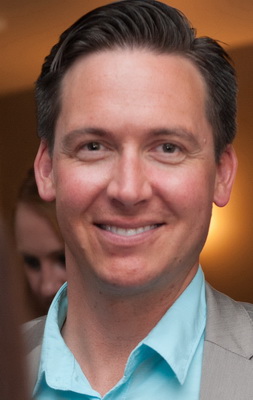 By Matt Steeves, CTV Morning Live
By Matt Steeves, CTV Morning Live
If my memory serves me right, one of the first bottles of wine I remember getting excited about was Wolf Blass Yellow Label, around the mid 1990s. I recall friends and family all thoroughly enjoying it too, and that was without a doubt our special occasion wine of choice.
Trends in the wine industry came and went. My passion for trying different wines from every corner of the earth put some time between me and the Wolf Blass brand. So it was only fitting that their Chief Winemaker visited our Nation’s capital on a very sub-zero March day, to walk us through his portfolio of wine and get us acquainted (again for many of us!) with the consistent, consumer focused, high quality products they continue to produce.
From their crisp Riesling (btw, Australian Rieslings are some of my favourite in the world!), to food friendly Chardonnay, then into their lovely Pinot. Finally, the full range of delicious reds, from Yellow Label, Grey Label, to the iconic Black Label. We were all impressed with just how great this storied winery continues to be.
If you haven’t tried a Wolf Blass wine in a while I’d strongly recommend you pick up some of their wines and enjoy them on a special evening. My favourite, as it delivers exceptional quality, complexity, and value, is the Grey Label Shiraz! http://www.nataliemaclean.com/wine-reviews/wolf-blass-grey-label-shiraz/214112
 By Heather Wall, Wine Columnist, Huffington Post
By Heather Wall, Wine Columnist, Huffington Post
On March 3, 2015 I had the pleasure of attending a Wolf Blass tasting with fellow wineaux led by Winemaker Chris Hatcher. I’m always intrigued at these tastings not just with the elixirs in our tasting glasses but more so by the stories behind the wines.
Wolf Blass is the man behind the brand, a common misconception by wine consumers. Wolf was born in Germany during WWII and shortly after the dissolution of the war he was shipped to his uncle’s vineyard in hopes that he might avoid the uncertainty in Eastern Germany. It is here that he studied winemaking and perhaps sparked his criteria of “quality, character, and consistency.”
As a twenty-something in the Old World of winemaking, he felt constricted and heard the calling of the New World. With lots of knowledge and little cash, he arrived in sunny Australia prepared to make his mark in this vastly different terroir. In
In 1969, with 2.5 acres of land Wolf Blass, the man, launched Wolf Blass the brand. Today it is the home of colourful labels and beautifully consistent wines of character and quality.
We tasted 9 wines from the various labels guided with the expertise of winemaker Chris Hatcher. The standout for me was the Gold label Riesling. I don’t usually think of Riesling in conjunction with Australia, however, this was nice throw back to Wolf’s German roots.
Chris admits that in the 1970’s he made wine using science. Today he makes wine in the vineyard aided by modern technology such as infrared mapping, blending, berry selection, and site selection – all components Chris uses today to ensure the wines meet Wolf Blass’ criteria.
I’d like to thank Chris for his time and Social Restaurant in Ottawa for the delicious lunch.
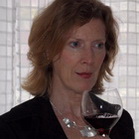 By Jane Staples, Wine Columnist, Windsor Star
By Jane Staples, Wine Columnist, Windsor Star
Several Sommeliers and wine professionals gathered in a lovely stone-walled room at Social restaurant for a great tasting and lunch to learn about Wolf Blass wines. I always appreciate the opportunity to learn about wines straight from the winemaker, who includes cultural information and anecdotes as he talks.
Being a people person, one of my favourite aspects of these tastings is hearing about the people behind the wines, in this case about the life and career development of Wolf Blass and how he developed such a successful winery.
I also have found that Sommeliers tend to be the nicest kind of folk; for me the camaraderie and mutual regard at these gatherings are richly rewarding. Good food, great wines, learning and sharing with friendly colleagues – it doesn’t get much better!
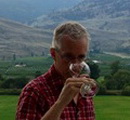 By Sean O’Regan, Director of the National Capital Sommelier Guild
By Sean O’Regan, Director of the National Capital Sommelier Guild
What’s better than enjoying lunch accompanied by some great wines? Add in Chris Hatcher, winemaker for Wolf Blass, great company and good conversation for a memorable experience. Having spent the past 26 years at Wolf Blass, Chris was able to provide a great overview and history of the winery and Wolf Blass himself as well as the changes that have taken place over the past four+ decades. One thing that has remained constant however is the drive to provide Quality, Character and Consistency in the products.
One topic came as a bit of a surprise when Chris was answering a question on where he thought the sweet spot was on aging premium wines such as the Black and Platinum labels. Chris explained the difference of how wines age between using the Stelvin scew cap closure and the cork closure – complete with graphs drawn on the back of a menu.
Since the screw cap does not allow any exchange of air the way natural cork does, agable wines will take several more years to develop tertiary properties as compared with cork, but should maintain a much longer lifespan in the cellar. It was surprising to hear that the use of the Stelvin screw cap enclosures were first used on the premium wines, before working their way down to replace the corks on entry level wines.
 By Jennifer Macdonald, Sommelier
By Jennifer Macdonald, Sommelier
I especially loved listening to him talk about Riesling and how it is a “wine makers” wine. I enjoyed hearing his passion for the craft as he described trying to create a wine that truly represented that grape, and I felt like I really “got it” when I tried the Riesling.
It was fresh, pure, flavourful, and everything he described. It was also great to hear about subtleties within regions and gave me some new insight into the many different regions of Australia.
His passion is evident and it sounds like he truly enjoys sharing his knowledge and experience with others, lucky for us :)
 By Monique Ippolito, Sommelier and Wine Tasting Instructor
By Monique Ippolito, Sommelier and Wine Tasting Instructor
Having an extraordinary proficiency in the art of blending is not something coveted by just the world’s leading whisky distillers or private bottlers; but by passionate wine producers as well. I endorse that wine (its characters, qualities and everything we love about it) originates in the vineyard but I respect winemakers just as much as much as the terroir. The winemaker’s passion, the science, their traditions, and in some cases even magic plays a role into creating a quality product.
Having had the opportunity to gain a little background into the world of Wolf Blass with chief winemaker Chris Hatcher, my respect for winemakers (and their blending skills) surged! Chris shared a wealth of knowledge with our little group, but the one that stuck with me was an anecdote from his very first days working as a winemaker.
He had the task of tasting and making notes of wine samples from 150 different casks. The key purpose of course was to figure out a blending strategy. I can only imagine how intimidating this can be! Nevertheless, the fine folks at Wolf Blass get the job done.
They come up with several quality tiers of blends, all the way up to a single vineyard blend each year. Single vineyard bottles are considered the creme of the crop by many wine nerds/geeks/collectors (myself included) – they wouldn’t have done it if it wasn’t great, right?
One key blend to note however, is their Black Label brand. The Black Labels are blended from the best casks from some of their best vintages and it is quite remarkable. I know many winemakers do this but I never considered such a practice to be as respected as a single vineyard bottle.
The Wolf Blass Wines Private tasting was a great opportunity to not only learn about the technical aspects they use to make their wines, but also a chance to learn about the people behind the brand and their winemaking philosophy. “Quality, character, and consistency” are at the forefront when making their wines to ensure a positive customer experience.
Chief Winemaker, Chris Hatcher was able to share with us some of his experiences with Wolf Blass, who unbeknownst to some, is an actual man and not just a winery. Chris Hatcher shared with us his thoughts on various wine topics, and reminded us that the taste is what winemaking is all about at the end of the day. Wolf Blass Wines accomplishes this by providing great tasting wines for great value.
We were lucky to have spent some time with the chief wine maker for Wolf Blass, Chris Hatcher, tasting a variety of their wines of all different colours (yellow, gold, grey and black labels- signifying the levels of price and quality). We were given the chance to hear about and taste some of the more refined wines that Wolf Blass is now producing.
My impression was that the wine making process is not compromised, even at a large scale winery such as this. They use French oak barrels for the most part, use gravity fed tanks and stress terroir expression. It was even mentioned that they would like to emulate the more refined and elegant styles of old world wines, which they have done quite well with some of their wines that we tasted, from Riesling to Syrah.
Wolf Blass has been around since the 70’s, when they won some prestigious Australian competitions and that tradition of quality continues to this day. They have some consistently well-made and delicious wines, at a varying price points making them accessible to just about anyone interested in an Australian wine from a reputable producer.
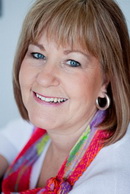 By Mary Anne van Gaal, Wine Blogger
By Mary Anne van Gaal, Wine Blogger
I found it most interesting to hear how blends are actually made. I would have thought that there was a formula for what percentage of what variety of grape that was used every year.
It was surprising to hear that winemakers rely on taste depending on the vintages to make the blend. However when I think more about this, it makes total sense and proves that winemaking is as much an art as a science!
This event was one of those that will be embedded in my memory forever. The wines and food were spectacular (I will definitely be paying Social a visit again soon). Having Chris Hatcher there in person to talk about Wolf Blass and the wines individually was fantastic. He was so interesting and knowledgeable – the time flew by. I could easily have spent a few more hours just hearing his stories and wine wisdom.
I enjoyed all the wines and again it brought home the point that Wolf Blass consistently make great wines in all Label levels. My favourites were the Pinot which surprised me as coming from Australia. I would have expected something more full-bodied. Instead it was refined and elegant. I also LOVED the Black Label Cab Sauv. blend with my steak – it was the perfect match!
Thank you again for inviting me, really appreciate the opportunity. To me a good wine is not just about the wine itself – it’s about the experience, the who, what, where and when that make wines memorable. This was one of those occasions!
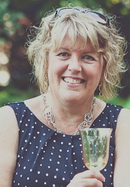 By Donna Hargrove, Wine Blogger
By Donna Hargrove, Wine Blogger
What a pleasure it was to meet and listen to Chris Hatcher. The history behind the wines we tasted certainly gave them more personality. I especially enjoyed Chris’ story of how the Black Label Cab/Shiraz blends are selected based, not on science or recipe, but through an expert sampling of a large selection of wines, narrowing the field to ensure the blend contains only the best vintages. Chris, much like the great Wolf Blass, is quite humorous and entertaining. A wonderful event!
Having the winemaker talk about his goals and his approach to winemaking is very much like hearing a painter talk about his approach to art, or a cabinetmaker talk about the design and construction of one of his creations; it’s all about craftsmanship. It’s a combination of art and science. Creating something that makes people happy and goes well with food is an added bonus.
It was amazing to hear how close a relationship Mr. Hatcher has with the the vines, and the level of detail that is involved in getting the most out of their grapes. It almost seems to go down to the level of individual wines.
I’d asked him about the driver of the quality increase in Wolf Blass wines over the years, thinking perhaps it was the age of the vines, but his answer was that their crop management allows them to grow better grapes. I was surprised to hear that he himself blends the wines as well, where I’d assumed it was a group of ‘tasters’.
For those really interested in wine, meeting a winemaker of Mr. Hatcher’s status is much like meeting a rock star, and some have the autographed bottles to prove it.
Winemaker Chris Hatcher of Wolf Blass wines came to visit the other day and though it was some of the coldest weather he had experienced it was no match for his warm, welcoming attitude as he shared some of the philosophies and wine making techniques he employs at one of the most successful wineries in the world.
He began with tales of the man behind Wolf Blass, Wolf Blass himself, who wanted a new start in a region free of the restrictions of German wine making. It was interesting to hear the winery’s history, the strategy behind their five tier wine portfolio, and the modern techniques used to accomplish that.
Australia, as it turns out, has some of the most varied soil composition anywhere and Wolf Blass uses infrared imaging to analyze the terrain. From there the best grape per area is planted, and viticultural techniques such as irrigation and mulch cover are used to get the most from each parcel.
Tasting through the range, we sampled crowd pleasing Yellow label wines, Gold labels that feature the best grape variety per growing region with controlled yields, the Grey label shiraz with further richness and complexity, and finally the Black label cabernet-shiraz which selects the top barrels from Grey level production in a final blend that combines the best qualities from the best parcels to produce the best wine possible.
It was a pleasure to be there but next time Chris, please bring a bottle of the Platinum.
To see the Tasting Team’s notes and scores, click on the wine names below
Wolf Blass Gold Label Riesling 2013
Australia $20.95
Wolf Blass Yellow Label Chardonnay 2014
South Australia $14.95
Wolf Blass Gold Label Chardonnay 2013
Adelaide Hills, South Australia $24.95
Wolf Blass Gold Label Pinot Noir 2012
Adelaide Hills, Australia $21.95
Wolf Blass Gold Label Syrah 2012
South Australia $24.95
Wolf Blass Yellow Label Cabernet Sauvignon 2014
South Australia $16.95
Wolf Blass Gold Label Shiraz 2012
Barossa, South Australia $25.00
Wolf Blass Grey Label Shiraz 2013
Mclaren Vale, Australia $34.95
Wolf Blass Black Label 2010
South Australia $91.25


